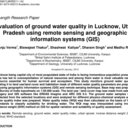Phytotoxic effects of chromium and tannery effluent on growth and metabolism of Phaseolus mungo Roxb.
Nyckelord
Abstrakt
The various dilution levels of treated tannery effluent (T.E.) (10, 25, 50 and 100%) and Cr6+ (0.5, 2.0, 5.0 and 10 ppm) were used in experiment to know their effect on seed germination, seedling growth, pigments and enzymes content in Black gram (Phaseolus mungo Roxb.). Chromium is known as the main toxic component of tannery effluent so its various concentration were given to know their effects. For the recovery of plant damage, protective value of 10 and 25 ppm of zinc, potassium and iron sulphate were also given with 50% treated tannery effluent and 10 ppm Cr6+ levels in separate petridishes. The different concentrations of tannery effluent and Cr6+ showed significant reduction in germination percentage, seedling growth (plumule and radicle length, number of lateral roots, fresh and dry weight, and moisture %) and pigments (chlorophyll, pheophytin and carotenoids) with increase in concentrations. The lower doses of tannery effluent (10%) and Cr6+ (0.5, 2 and 5 ppm) slightly increases the pigments concentration. The amylase activity and total sugar contents were also significantly decreased while catalase and peroxidase activity showed significant increase with rise in concentrations of treatments. The lower concentrations of tannery effluent (dilution 10 and 25%) and Cr6+ (0.5 and 2 ppm) showed significant increase in total protein contents while decrease at higher concentrations. The zinc, potassium and iron treatments led to recover the damage caused by chromium and tannery effluent in all parameters. In recovery treatments zinc showed highest and significant recovery in maximum parameters. Iron also showed almost similar effect to the zinc while potassium showed minimum recovery.


